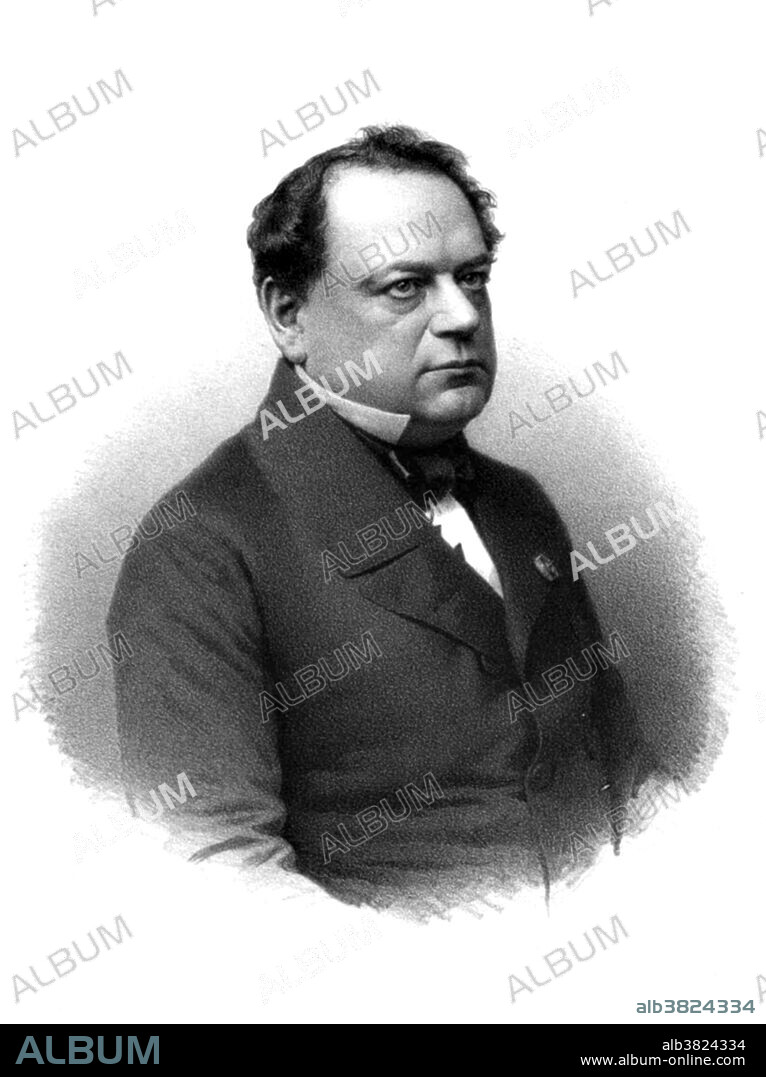alb3824334
Moritz von Jacobi, German Physicist

|
Add to another lightbox |
|
Add to another lightbox |



Buy this image.
Select the use:

Title:
Moritz von Jacobi, German Physicist
Caption:
Moritz Hermann von Jacobi (September 21, 1801 - March 10, 1874) was a German engineer and physicist. In 1834 he began to study magnetic motors. He moved to Saint Petersburg in 1837 to research usage of electromagnetic forces for moving machines for Russian Academy of Sciences. While studying the transfer of power from a battery to an electric motor, he deduced the maximum power theorem. Maximum power is transferred when the internal resistance of the source equals the resistance of the load, when the external resistance can be varied, and the internal resistance is constant. He obtained his theorem by common sense. In 1838, he discovered galvanoplastics, a method of making printing plates by electroplating. The way in which this works is analogous to a battery acting in reverse. The stereotype was an impression taken from a form of movable lead type and used for printing instead of the original type. In 1839, he constructed a 28 foot electric motor boat powered by battery cells. He also worked on the development of the electric telegraph. In 1842-45 he built a telegraph line between Saint Petersburg and Tsarskoe Selo using an underground cable. He died in 1874 at the age of 72. He was a brother of the mathematician Carl Gustav Jacob Jacobi.
Credit:
Album / Science Source / Smithsonian Institution Libraries
Releases:
Model: No - Property: No
Rights questions?
Rights questions?
Image size:
3300 x 4409 px | 41.6 MB
Print size:
27.9 x 37.3 cm | 11.0 x 14.7 in (300 dpi)
Keywords:
1801 • 1874 • 19TH CENTURY • ART • ARTWORK • BORIS SEMYONOVICH • BROTHER • BW • CARL GUSTAV JACOB JACOBI • CARL GUSTAV JACOBI • CARL JACOBI • CAROLUS GUSTAVUS IACOBUS IACOBI • CELEBRITIES • CELEBRITY • DRAWING • ELECTRIC MOTORS • ELECTRIC TELEGRAPH • ELECTROMAGNETISM • ELECTROPLATING • ELECTROTYPING • ENGINEER • EUROPEA • EUROPEAN • EUROPEANS • FAMOUS PEOPLE • FAMOUS • FIGURE • GALVANOPLASTICS • GERMAN • GERMANS • HISTORIC • HISTORICAL • HISTORY • ILLUSTRATION • ILLUSTRATIONS • IMPORTANT • JACOBI • JEWISH • KARL GUSTAV JACOB JACOBI • KARL GUSTAV JACOBI • KARL JACOBI • MALE • MAN • MAXIM POWER THEOREM • MAXIM POWER THEORY • MEN • MORITZ HERMANN JACOBI • MORITZ HERMANN VON JACOBI • MORITZ JACOBI • MORITZ VON JACOBI • NOTABLE • PEOPLE • PERSON • PERSONALITIES • PERSONALITY • PHYSICIST • PHYSICS • PORTRAIT • POTRAIT • RELIEF PRINTING • SCIENCE • SEMYONOVICH • TELEGRAPHY • VON JACOBI • WELL-KNOWN • WIRE TELEGRAPHY
 Pinterest
Pinterest Twitter
Twitter Facebook
Facebook Copy link
Copy link Email
Email
